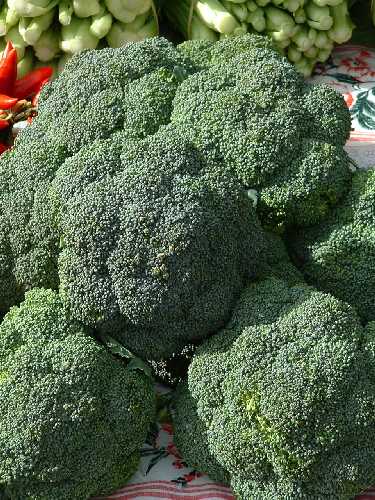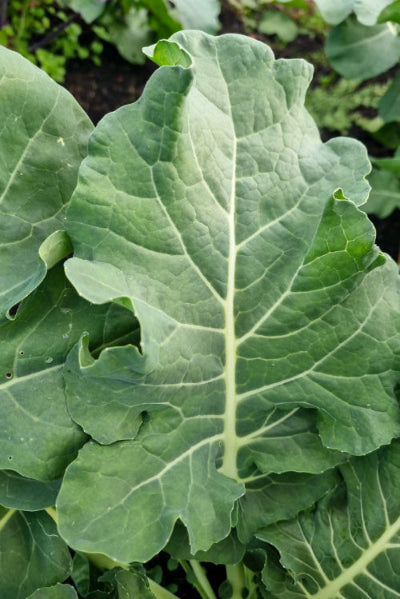How to Grow Broccoli & Broccoli Raab

The essential guide to growing kale from seed; with notes on germination, cultivation, harvest and even kitchen uses.
Ave. Seeds per Gram: 240–350 seeds per gram.
Germinating Temperature: 14°C to 30°C. Under these conditions, seeds typically sprout in 5–10 days.
Feed Requirements:
- Moderate feeders.
- Respond well to additional fertilizer or a sidedress of compost or balanced organic fertilizer as heads begin to form.
- Provide plenty of regular watering to ensure steady growth and prevent stress.
Growing Notes:
- Vigorous, Tasty and Cold Hardy: Broccoli thrives in cooler conditions and does not appreciate the intense heat of mid-summer. In many regions, growers avoid sowing seeds in November to early January to prevent seedlings from becoming leggy.
- Extended Harvest Period: With clever planning, you can harvest broccoli for all but 8–10 weeks of the year. Start seedlings from early August for spring planting, transplanting them at the 5–6 leaf stage. Or sow seeds direct 0.5 cm deep, 4–6 per spot, thinning to the strongest seedling, with a 60 × 60 cm spacing.
- Timing for Cold Areas: In regions with a cold winter (e.g., Derwent Valley or Lorinna), sow seeds early in the new year. Elsewhere, mid-to-late January – February sowings work well.
Variety Choice:
- Italian (Calabrese) Broccoli: The common supermarket type. Produces a large main head followed by smaller side shoots if conditions remain favorable. In cold winters, this type may freeze or cease production.
- Purple Sprouting Broccoli: A biennial that better withstands cold winters, producing abundant heads in late winter and early spring when other crops are scarce. It needs to overwinter before forming its tasty purple heads.
General Care
- Maintain regular watering—consistent soil moisture is key.
- Provide ample fertilizer around the time spring bulbs appear to encourage strong head formation.
- To avoid a glut, sow different maturity types or a blend of varieties that develop at different rates.
Common Problems & Pests
- Cabbage White Butterfly / Cabbage Moth
- The larvae (cabbage grubs) can cause significant leaf damage.
- Regular use of Dipel (Bacillus thuringiensis), a non-toxic biological control approved for organic growers, can help keep them in check.
- Alternatively, physical barriers like row covers or insect netting can prevent egg-laying on the plants.
- Try Land Cress to act as a decoy, attracting the pesty moths to them.
Harvesting Notes
- When to Cut: Harvest the main head when the florets (beads) begin to swell but before they open or show yellow flowers.
- Encouraging Side Shoots: Cutting the central head spurs the plant to produce side shoots from the leaf notches, providing multiple mini-harvests. Slower-maturing varieties often produce more side shoots, extending your harvest window.
- Regular Harvesting: Continuously pick side shoots to keep the plant productive. Prompt harvesting prevents the plant from diverting energy into flowering and helps maintain tender, tasty florets.
- Nutritional Benefits: Broccoli is rich in vitamins, minerals, and phytochemicals (notably sulforaphane and indoles), which are linked to anti-cancer benefits. Best enjoyed lightly steamed or raw to preserve maximum nutrients.
Enjoy the satisfying crunch and abundant health benefits of homegrown broccoli nearly year-round with proper timing, regular feeding, and vigilant pest control!
Sowing Periods
| J | F | M | A | M | J | J | A | S | O | N | D | |
|---|---|---|---|---|---|---|---|---|---|---|---|---|
| Cool | ||||||||||||
| Temperate | ||||||||||||
| Sub-Tropical/Tropical |
Filters
8 products
BROCCOLI 'DI CICCO'
Sale price$3.75
BROCCOLI ‘Arcadia’ F1
Sale price$3.75
BROCCOLI ‘Green Magic’ F1
Sale price$3.80
BROCCOLI ‘Marathon F1
Sale price$4.20
BROCCOLI ‘Purple Sprouting’
Sale price$3.75
BROCCOLI ‘Romanesco’
Sale price$3.75
BROCCOLI ‘Spigariello Liscia’
Sale price$3.75
BROCOLLI RAAB 'Spring Rapini'
Sale price$3.75







